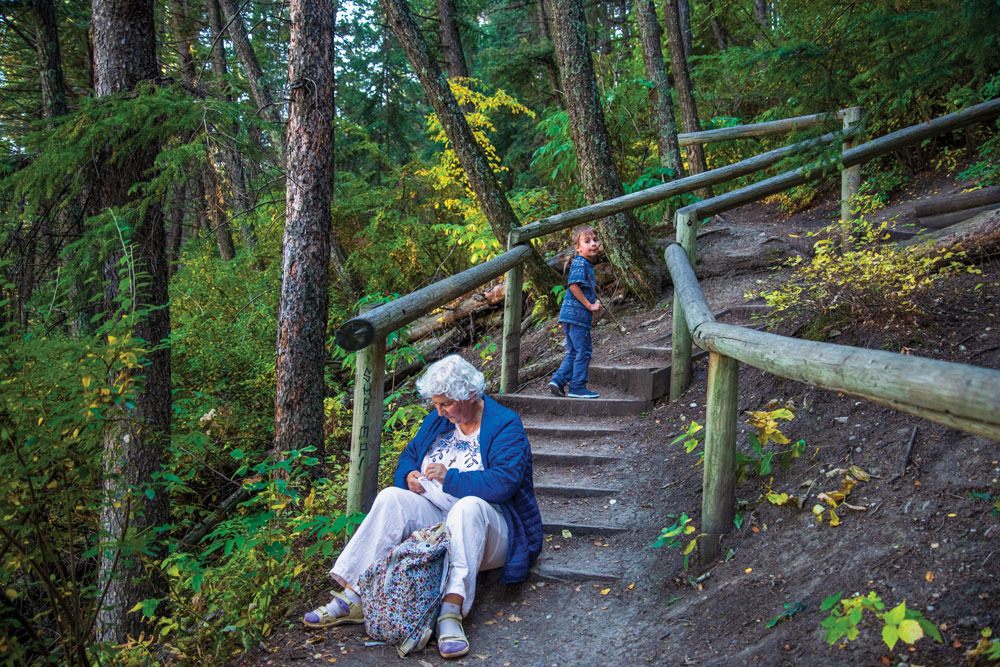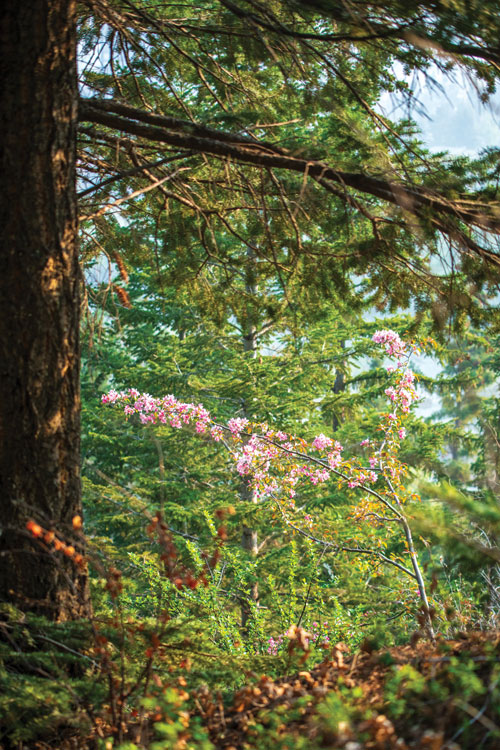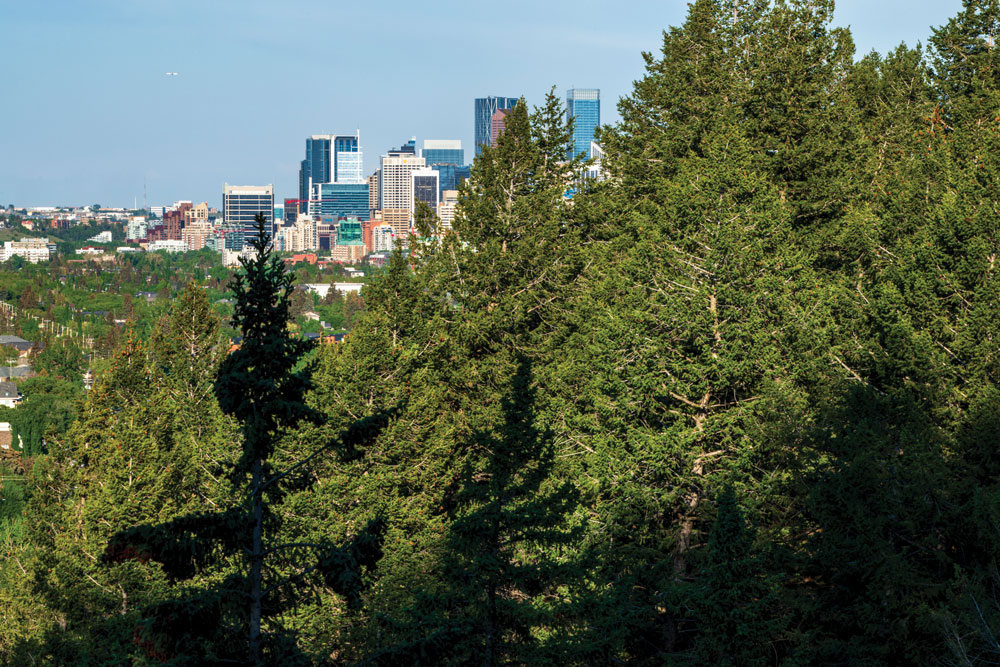In many ways this patch of wilderness seems not to belong here at all. A scientific survey of the area in 1981 identified more than 400 species of flowering plants growing on the escarpment, including the bog orchid, identified only once before in Calgary, and the rattlesnake plantain, which had never previously been found here. Even the eponymous trees, some over 400 years old, are biologically misplaced. Douglas firs are rarely found this far east.
Of course, there are other, more banal reasons why such a patch of untouched forest would be anomalous in a city like Calgary: development and sprawl—phenomena far more of this place than those towering trees. As early as 1982, only a decade after the trail was first built, a Calgary Herald journalist remarked that she “half expected the trail to be gone and suburbia moved in.” Historically, Calgary’s untouched areas rarely remain untouched for long.
The Douglas Fir Trail owes its unlikely existence, and half-century longevity, to members of the nearby communities who have, time and again, rallied to its cause.

The trail winds up and down and across a steep escarpment that has never been entirely stable. City of Calgary officials noticed slope failures as far back as 1920, and such fragility requires occasional attention. In 1992 the City shut down the trail for renovations. Municipal officials partnered with the Edworthy Park Heritage Society, who in turn activated a crew of about 20 volunteers to spend sunny weekends helping out with the rehabilitation. In addition to repairing and rebuilding trail infrastructure such as bridges and railings, five different greenhouses took on the task of raising wildflower seedlings and native grasses to revegetate bare patches of the trail. Dogwood and fireweed. Wild roses and bergamot. Gooseberries and snowberries. Twenty-six varieties in all, each with a genetic link to the hillside’s ecosystem.
By the time the trail reopened in 1994, volunteers from the society, local Scout troops and other community organizations had contributed over 1,000 hours of labour to the revitalization project. The workers built seven new bridges, spread eight truckloads of sand, gravel and clay by hand over the pathways, and planted 5,000 wildflowers.
Mike Bracko started running the Douglas Fir Trail not long after the reopening. He and his dogs have been regulars ever since. Bracko lives a four-minute walk from the trailhead, in the community of Wildwood. For 30 years he’s run the route nearly every day in the spring and summer, and at least twice a week during the winter. In 2016, on one of his autumn runs, Bracko found the trail blocked by metal fences hung with orange signs warning that the trail had been closed, again, “due to flood-related damage and stability concerns.”
Bracko promptly started a Facebook page called Save Douglas Fir Trail to draw attention to the closure. Repair work started on the trail the following summer, and Bracko used his Facebook page to rally volunteers to help in the effort just as the Edworthy Park Heritage Society had done in the early 1990s. Again community members assisted city workers in building new bridges, rope railings and stairs. The trail reopened in November 2017.

Those renovations, though, weren’t built to last. According to Amir Wazir, a geotechnical engineer with the City of Calgary, the structures installed in 2017 were designed in consultation with the Calgary Mountain Bike Alliance rather than with municipal engineers. “The trail wasn’t built according to city standards,” Wazir said, and had a design life of only two to five years. Sure enough, by 2023 city officials noticed enough degradation and erosion to close a long portion in the middle of the trail where, according to their press release, “the boardwalk, railing and steps have failed, and where the terrain has been deemed hazardous for public use.”
The city also announced an erosion and drainage study on the central slope. Wazir believes the city will complete the slope analysis by the end of 2024, at which time they’ll decide what to do next. In the meantime, the fences and warning signs went up on either end of the closed portion to keep users off the trail.
The trail owes its unlikely existence to community members who have, time and again, rallied to its cause.
Bracko fears that if the city’s analysis concludes the ridge is shifting, the whole trail may be permanently shut down. “Decommissioned,” Bracko said. “That’s a word I heard a lot back in 2017.” And just like in 2017, Bracko is calling on community members to step up and advocate for their beloved trail.
Elise Burgert, a former ranger at BC’s Golden Ears Provincial Park, will be one of them. Burgert moved from Vancouver to the Calgary community of Montgomery in the summer of 2023. “The trail is probably the most beautiful thing about the community and one of the reasons why I moved here,” Burgert said. She crosses the Bow River at Edworthy Park several times a week to walk her dog along the Douglas Fir Trail. “He’s a very adventurous dog,” she said.
Burgert rejects the city’s claim that the trail is too dangerous. “That’s not really a thing,” she said. “It’s just that they didn’t put in the effort of maintaining it. You can build a trail anywhere you want.” Burgert’s experience building and maintaining trails has taught her that such closures are too often permanent. She’s seen the same sort of thing happen in and around Vancouver. “Once you lose them, they’re gone forever,” she said. “It’s really easy to take away natural spaces, and really hard to [get] them back.”

After seeing the trail closure, Burgert reached out to Save Douglas Fir Trail on Facebook and offered to contribute to whatever community efforts were being planned. “Hopefully in the springtime there’s some [way] for people to get involved and help. That’s what I want to do. Just chip in and spend a day or two if possible with other people in the community and fix it.” Burgert believes the city could simply dig some culverts to help with drainage and build a bridge across the wash with two trees. In fact, Burgert figures she could do it herself with a chainsaw and some tools. She’s done it before. “When it comes to building trails, you just have to work with what you have,” Burgert said.
“I don’t think it’s equivalent to the moon landing to build a bridge there,” Burgert said. “The city just needs to want to.” If the city decides to close the trail instead of repairing and maintaining it, she’s confident the community would rally to maintain the trail themselves. This, she said, happens all the time where she’s from; BC employs a “more laissez-faire attitude” to trail maintenance. Instead of fencing off and closing down a trail, the government simply declares a trail unofficial. “You use it at your own risk,” Burgert said. “And if you want to get a group together to fix it, the government might support you. Otherwise they just stop putting the trails on official maps.”
Both Burgert and Bracko believe people will continue to use the trail whether it’s officially off-limits or not. “I’m not promoting civil disobedience,” Bracko said. “But I literally don’t know how they can close a trail.” He recalls when a part of the escarpment slid down during the flood of 2013. “It was actually pretty amazing what happened,” he said. “So many people use the trail that eventually everybody, including myself, made a trail through the tangle of trees.” And when the city closed the trail in 2016, people just removed the fences. “So it’s almost like no matter what h
appens—if it’s an act of God or if it’s the city—we’re still going to find a way to use the trail.”

Both Burgert and Bracko believe people will continue to use the trail whether it’s off-limits or not.
Still, if the city decommissions the Douglas Fir Trail and stops maintaining the stairs, railings and boardwalks, it could become inaccessible to all but the most adventurous users. This would be unfortunate. Many Calgarians use the trail nearly every day, especially in the spring and summer. “That’s their daily walk,” Bracko said. For locals intimidated by “actual wilderness,” the trail provides an opportunity to commune with nature a short walk from their own front doors. It offers social time, too. Women’s walking groups frequent the trail, and Bracko has seen three generations of families walking together during the summer months. “They hike as a family,” Bracko said. “It’s just the best thing.”
For Burgert, losing the trail would mean losing the wide view of her own neighbourhood of Montgomery, her new home, from the lookout on the other side of the Bow. “Every time I go up there I feel really magical,” she said. “I cross the river and hike up. I get a progressively nicer view of Montgomery.” She’ll especially miss its proximity. “Without the trail, I guess I’ll have to drive every time I want to go somewhere to get away from things,” she said. “Which is a completely different experience.”
Wazir, however, feels confident that the trail will eventually be returned to users. But he stresses it needs to be rehabilitated properly. If the analysis shows the slope isn’t safe, “then we’re going to make it safe,” Wazir said. “And then we’ll rebuild the trail according to the standards the city follows, and that will be for a much longer term than five years.”

This prediction could relieve the trail’s defenders, whether they are long-time trail runners like Bracko or newcomers like Burgert. “There is so much peace having something like that so close to home,” Burgert said.
Marcello Di Cintio is the author of Driven: The Secret Lives of Taxi Drivers.
Guillaume Nolet is a photographer who documents society culture and rural life.
____________________________________________

